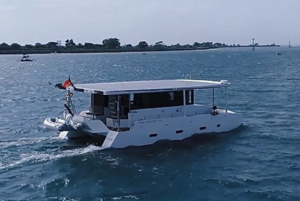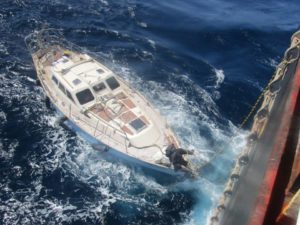New era of search and rescue drones for MCA

Large drones, similar in appearance to those hitherto seen only in conflict zones, are being tested which would allow the Maritime and Coastguard Agency (MCA) to fly rescue missions in conditions and for a duration currently impossible for manned aircraft as previously reported in MIN.
Elbit Systems UK has been selected by MCA to conduct maritime demonstration flights in the UK using a number of its unmanned aerial systems (UAS) including the Hermes 900. The demonstration flights are designed to show the advantages of using long-range unmanned capabilities in civilian airspace, with the ability to utilise multiple sensors on a single platform.
With a wingspan of 15 metres, the 1.2-ton Hermes 900 Maritime Patrol is a long-range maritime surveillance system tailored for littoral and blue water operations. It features maritime radar, an Electro Optic payload, Satellite Communication, an Automatic Identification System receiver, and an Emergency Position-indicating Radio Beacon receiver. The Hermes 900 Maritime Patrol enables persistent monitoring of vast swathes of sea and long coastlines with effective advanced search capabilities to support with valuable search and rescue work as well as the identification of potential hazards. Elbit Systems’ Skylark I-LEX will also be taking part in the demonstration flights.
At some point in the late summer, the Israeli-built Hermes 900 drone will begin flights from Aberporth Airport on the Welsh coast as part of a £1m trial programme. The drone is one of several set to be assessed by the MCA before it awards a multi-million pound contract likely to use both robotic and manned aircraft for tasks from rescues to monitoring pollution, according to inews.co.uk.
Among the advanced capabilities of the Hermes 900 unmanned aerial vehicle (UAV), which can fly for up to 24 hours at a time, is a system to deliver up to four six-person life rafts from an altitude of 600ft. Elbit Systems, the defence company behind the Hermes 900, claims the system means rescue is possible “in adverse conditions day and night” where a helicopter or fixed-wing aircraft could not help.
Seemingly drone operators would be able to calculate the correct spot to drop the self-inflating rafts to ensure they are carried by wind and current to those in distress, according to inews.co.uk.
The head of Elbit’s UK operation, Martin Fausset, says the MCA has been “briefed” on the life raft system, which has already been supplied to an unnamed Asian country, and could help those in need from a sinking cargo ship to a holidaymaker who has strayed too far from shore. It is understood that while the life rafts will not form part of the initial trial, deploying the system at a later date has not been ruled out.
Frontex, the EU’s joint border agency, has signed contracts worth 59m Euros (£53m) to deploy Hermes 900 drones over the Mediterranean and elsewhere to monitor migrants and refugees trying to reach Europe. Meanwhile, a Portuguese-made UAV has for the last six months made almost daily flights for the Home Office Border Force from Lydd airport in Kent to monitor trafficking gangs and illegal migrants crossing the English Channel.
Read the full article in inews.co.uk.










